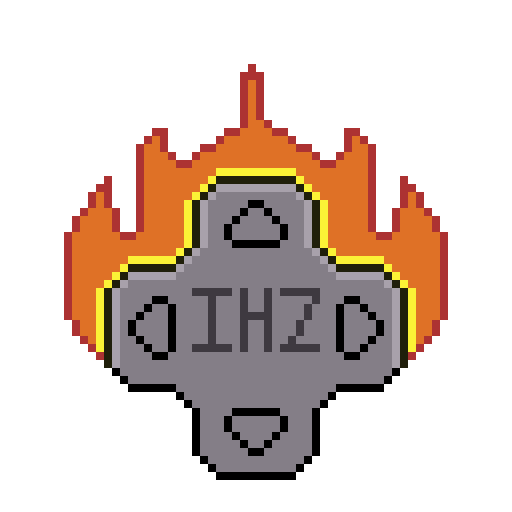We’re back to talking indie RPGs, but we’re not following up on the one I talked about last time. Because I’m a fucked person, I’ve been playing another RPG, so let me share that one! Rise of the Third Power? Darkest Dungeon? Don’t worry about it.
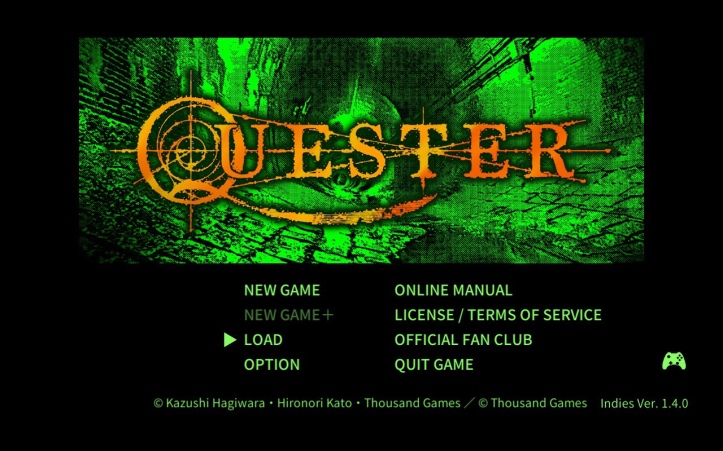
Today we’re looking at Quester, by Thousand Games. The world is post-apocalyptic, with a poisonous atmosphere and monsters roaming around. But despite it all, a group of randos come together to explore the wastes in this “dungeon exploration RPG specializing in hack-and-slash.” …I’m not sure what the promo means by hack-and-slash, but eh, let’s roll with it.
There are three principal figures associated with the game. The game design is by Hironori Kato, who previously worked on tabletop games – most notably he worked on playbooks for a Dark Souls TRPG. Lending him visuals is Kazushi Hagiwara, who’s famous for the seinen series Bastard!!; I never heard of it before, but it’s still ongoing and very recently had an anime series put on Netflix, which I’d probably check out if Netflix actually listens to striker demands. The game’s produced by Toshimichi Kuwahara, who previously just seemed to be on mobile Japanese games. It’s a strange mix of people, but does this mix succeed at putting something out?
When it comes to visuals, Quester is very minimalist. Exploration may as well just be walking around on a piece of graph paper, and combat are side-by-sides of character and enemy portraits just taking swipes at each other. Other sites have called this a more stripped down Etrian Odyssey, but to me, it really reminds me of Dungeon Encounters, an RPG with similar visual sensibilities.
I… also did not like Dungeon Encounters. In fact, my friend Fang gifted this game to me, calling it a version of Dungeon Encounters that isn’t evil. And I agree with him, because I actually like this game so far. It’d be easy to make comparisons, but I’ll try to avoid making them too much because it’s a reductive way of looking at things that aren’t directly related.
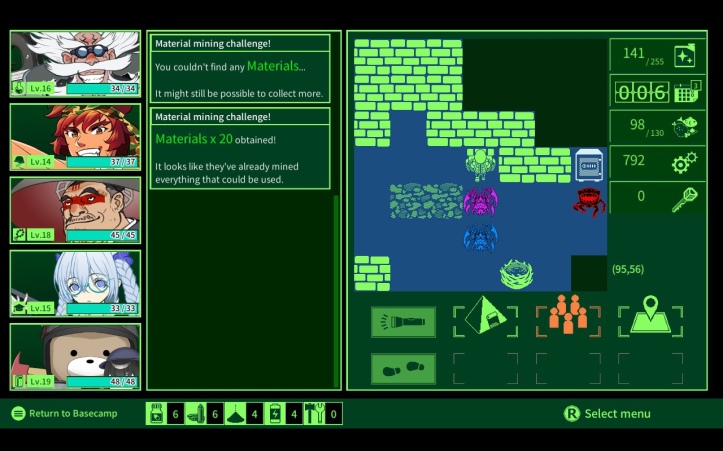
Exploring is mandated by purification fuel, the juiced that does everything. Every step takes a bit and digging through debris consumes a bunch. After a fight, purification fuel’s used to patch up party members with downed ones sucking up a whole bunch. Yes, you don’t have to worry about healing resources as much as you would in other RPGs, but if you want to make the most of your exploration day, you gotta get good at fighting. Mercifully, the game will just dump you back at base when you’re out of fuel, so you don’t have to worry about conserving for a return trip or anything.
But something you do have to worry about is food. You must gather a set amount of food before the end of each cycle of days. You may think “I should just spend a cycle farming food before exploring,” and you’re a fool for thinking this. Any excess food just gets converted to materials that’s used for leveling and weapon upgrades. As a result, you’re forced to constantly push on instead of hanging around one place, because you’re never getting anywhere in the game if you just farm.
Little by little, you’ll uncover parts of the map, clearing debris with precious purification fuel. You’ll find spots where food and materials are guaranteed to spawn, but most importantly, you’ll find new base camps, and you’ll need to spend food to relocate so that you can make further pushes into unexplored territory.
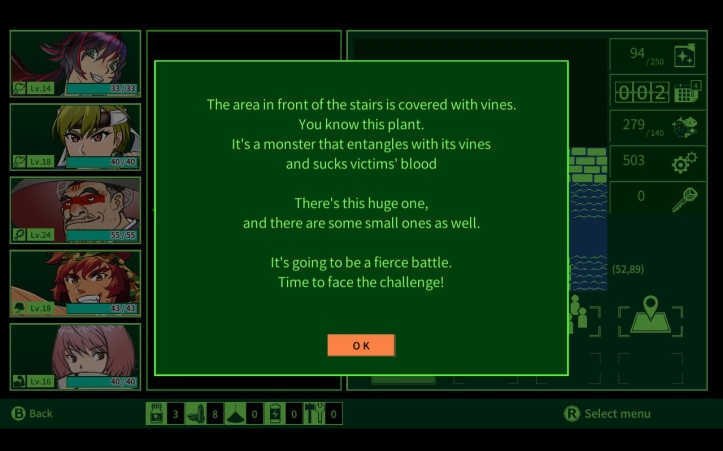
I like these systems that the game adds to the exploration because they made me think about how to explore. Do I want to use this first day to map out as much of the map as possible and hope to get food along the way, or should I start focusing on building up a store of food so I can just dedicate the rest of the cycle to exploration? Do I want to spend the food tax to relocate for more convenient exploration when I haven’t met the quota yet? Should I waste all this purification fuel digging through debris in hopes of finding something at the end of it? Will you be like me, a compulsive fool, and clear up parts of the map for personal satisfaction at the cost of time and resources? It’s engaging to me.
But inevitably, you’ll have to fight somebody. Simple monster sprites roam around as you do, with appearance indicating what you’re likely to fight and color indicating the relative strength of the mob. Get caught up with a red enemy gang and know you have no shot? Well, you can just run away at the expense of some purification fuel. Getting away from the jerk will be a different story, but as far as I’ve seen nothing’s stopping you from dipping out of even the stronger miniboss fights, so you have the freedom to choose your battles.
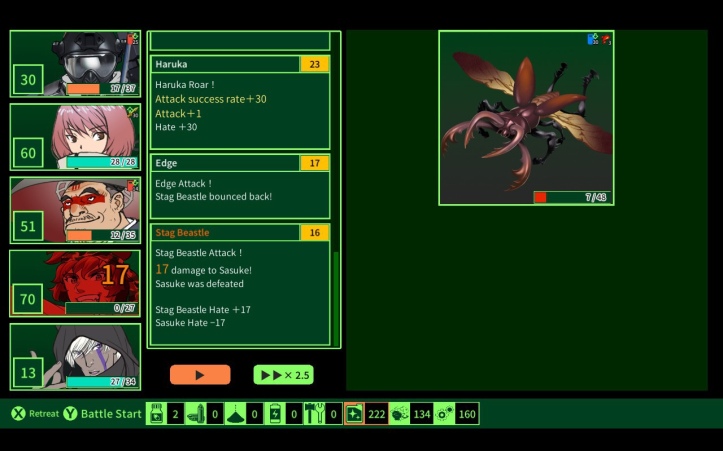
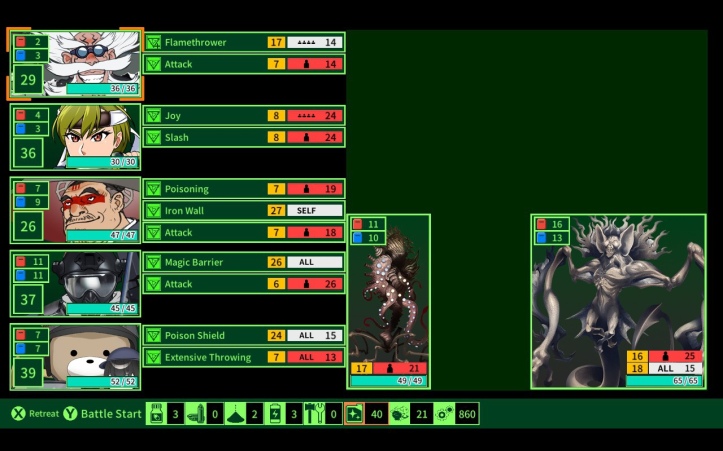
Speaking of which! You got your troop of five guys facing enemies in turn-based combat. Each character can choose up to three moves within a point cost and they’ll automatically use them in the fight. Some characters use resources that replenish at the start of each fight, but some moves let you make extra resources at the cost of purification fuel, if you’re willing to risk it.
One thing you’ve got to be mindful of is the hatred mechanic, represented by the big number next to each character portrait. Most of the time enemies will target highly hated people, which means that your heavy hitters will absolutely get ganged up on. As such, you’ll need to think about how you approach fights. It’d be easy to get a tank like Shake & Asuka to take on all the hate like the team’s crown of thorns, but it’d also be smart to have a team with a strong array of moves to juggle that hate around so that nobody gets too beaten down.
I guess if I had a complaint about the battle system it’s that the party targeting seems to prioritize targeting enemies with the least HP. It’s not necessarily a bad thing, especially when you’re fighting bosses with groupies, but it can kinda lead to wasted attacks like a strong hit against someone already close to death or somebody that probably would have just died to DOT. I dunno, this is probably nitpicky, but it just doesn’t flow with my personal sensibilities toward RPG combat.
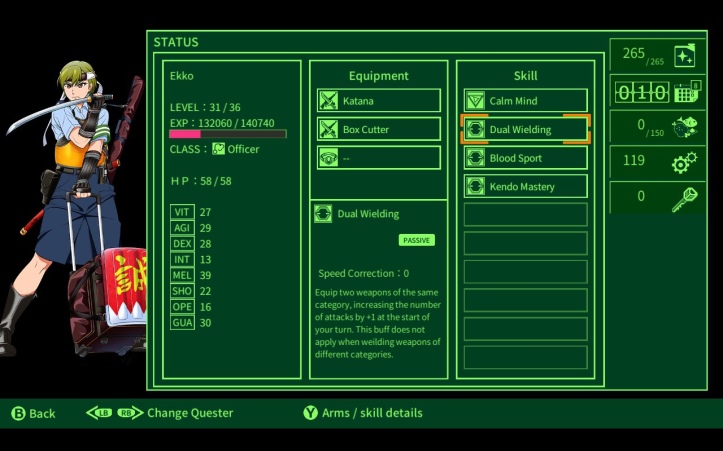
You got a nice array of guys to play around with, and while equipment can be interchangeable, they all have skills they learn to carve out their own niches. Dob-Rock the Buddhist has been a general mainstay because he has a group healing skill out of the gate, while I’m impartial to Ekko the Officer because of her passive skillset that makes her kinda nutty with bladed weapons. You’ll occasionally get new crew members at new base camps, and while that does raise your food costs, well, that’s just the price of friendship.
As for the character and enemy designs, I like them! The playable cast of Quester does remind me of Dungeon Encounters where everyone just has the one sprite and no unifying theme between them. Though, it feels more purposeful here, because it really is a game about complete random strangers coming together in a post-apocalypse. The story may be light, but you’ll get that impression in a game with sword swinging cops joining forces with a Buddhist priest and a random mad scientist they found off the street.
So far, I’m liking Quester. The gameplay comes together for the most part, and I really enjoy the exploration. With its lack of writing, Quester’s definitely entered my rotation of games to play while watching something (complimentary). I’m not sure if I’m ever going to make a post revisit like I want to with Rise of the Third Power, but this game’s a thumbs up for me.
